Anthologica Universe Atlas / Universes / Eleuthèa / History of the Eleuthean Empire / Monarchs and dynasties of the Eleuthean Realm
This is a list of monarchs of the Eleuthean Empire, which are known by the royal title Rhuv "king/queen" or Rhuverna "emperor". The crowned warlords and predynastic monarchs that ruled before the official foundation of the Kingdom of Eleuthea, including the Dhammaratian monarchs, are not shown. The list, therefore, covers the years 5556 to 6277.
Since Eleuthea's history is so long, it is not always possible to have contemporary portraits from each monarch's reign. Sometimes, this is due to the loss of information; sometimes, it's due to the exclusion of certain rulers from the official accounts (the condemnation of memory, or damnatio memoriae), which so often included the destruction of all the monarch's portraits, statues, and coins with his or her face. When that happened, too much information and data were lost, especially during the iconoclastic violences of the last decades of the Eleuthean Empire, and the Dhaula Varlauve.
For us, today, the only feasible way to recover the monarchs' faces and other information about these lost periods, is with the Mhëurednë's help, who can make use of their superior mental aptitudes to recover partial visions and voices from the past. The resulting portraits are not as clear as a photograph or as regal as an official painting, and some may appear too blurry or distorted. Obviously, the farther the past, the blurrier the image.
The Kingdom of Eleuthea was founded by Phalladas I after the unification of the Seven Petty Kingdoms, commonly known as Dhammarat "land of the marats" (Oel Dhammaratagt).
Established by Phalladas I. From 5556 to 5696 (140 years).
The Agtainid or Agtaeanid dynasty was established by Agtainas I. From 5696 to 5776 (80 years).
Scientific and technological breakthroughs propelled the Eleuthean society towards a level of sophistication not seen since the Arrival, making possible the expansion of the kingdom towards its classic limits, and the Eleuthean culture and civilization, to all continents in Aerglè.
The greatest of all Eleuthean royal dynasties, the one with the best fame, and the most beloved.
The Cöresgat Dynasty succeeded the Corhoenids during the Eleuthean First Civil War (5990 to 5993), when Dirmas usurped the throne at Ruvai Barnusa. The dynasty was known as "the Deformed Emperors" or "the Grotesque Emperors", because of its monarchs' experiments with biotechnology and genetic enhancement, which deformed their faces and bodies.
The Cöresgat Dynasty was followed by more monarchs with deformed faces and bodies. The next dynasty saw short-lived rulers with physical traits so grotesque, that most hid their faces and bodies under full golden helmets and attire. That gave the dynasty its name: the Golden Emperors, or the Golden Dynasty.
Since Eleuthea's history is so long, it is not always possible to have contemporary portraits from each monarch's reign. Sometimes, this is due to the loss of information; sometimes, it's due to the exclusion of certain rulers from the official accounts (the condemnation of memory, or damnatio memoriae), which so often included the destruction of all the monarch's portraits, statues, and coins with his or her face. When that happened, too much information and data were lost, especially during the iconoclastic violences of the last decades of the Eleuthean Empire, and the Dhaula Varlauve.
For us, today, the only feasible way to recover the monarchs' faces and other information about these lost periods, is with the Mhëurednë's help, who can make use of their superior mental aptitudes to recover partial visions and voices from the past. The resulting portraits are not as clear as a photograph or as regal as an official painting, and some may appear too blurry or distorted. Obviously, the farther the past, the blurrier the image.
Kingdom of Eleuthea
The Kingdom of Eleuthea was founded by Phalladas I after the unification of the Seven Petty Kingdoms, commonly known as Dhammarat "land of the marats" (Oel Dhammaratagt).
Phalladean Dynasty
Established by Phalladas I. From 5556 to 5696 (140 years).
| Image | Biography |
|---|---|
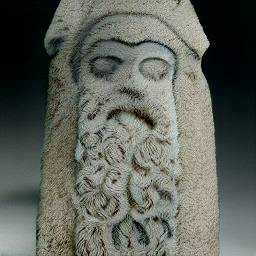 | Phalladas I was the founder of the Eleuthean Kingdom, and the first monarch of any Eleuthean political entity with the title Rhuve. He was the High Priest of the Eleuthean religion, and instituted a religious reform. He founded the first royal capital at Harbathhani, on the eastern edge of lake Ereilio. His reign lasted 55 years, from 5556 to 5611. |
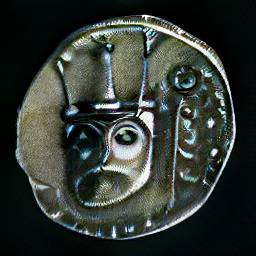 | Dirmas I, son of Phalladas I, concluded the construction of Harbathhani. He started wars against the Escinoans, a tribe from Hyesnë and the most problematic barbarized people in the Northern Moors. He was victorious in part, securing the valley of the Alezant river in what would become the Isternat province, but was killed in battle in his fourteenth year as a king. He ruled from 5611 to 5625. |
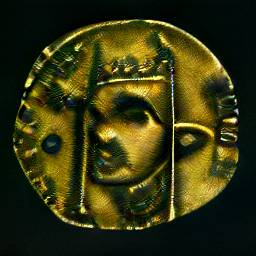 | Dalandas I the Good succeeded his uncle Dirmas half a year after his death. He finished the war against the Escinoans, which was already won thanks to the efforts of the generals that de facto ruled during the interregnum. With that, he annexed Hyesnë to the empire and put the first steps into annexing the remaining Northern Moors. He reigned from 5625 to 5640. |
 | Phalladie I, the first Rhuve of the Eleutheans, was Dalandas' sister. She's known for establishing an alliance with the Kingdom of Orhoí, beyond the Censayner Sea, to destroy Barbdunna, which became a reality in the year 5660. The creation of the Gardens of Harbathhani was her idea. She ruled for 56 years, from 5640 to her death, in the year 5696, and was succeeded by her grandson, Agtainas. |
Agtainid Dynasty
The Agtainid or Agtaeanid dynasty was established by Agtainas I. From 5696 to 5776 (80 years).
| Image | Biography |
|---|---|
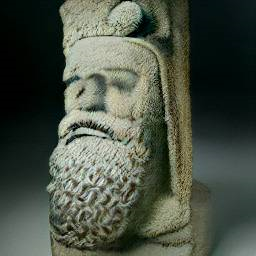 | Agtainas I. He ruled fom 5696 to 5734. |
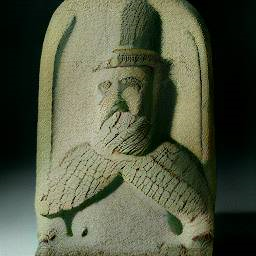 | Phalladas II the Lover of Gentleness. He ruled from 5734 to 5752. |
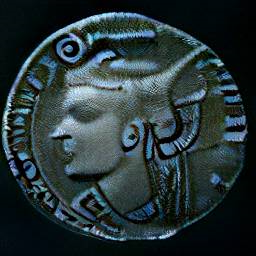 | Corhoene was the last monarch and queen of the Kingdom of Eleuthea. The definitive annexation of Mhuse (Thaniveturs) is thanks to her. She reigned from 5752 to 5776, when she passed the crown to her daughter, Eathonie, giving her the title of Empress. |
Eleuthean Empire
Scientific and technological breakthroughs propelled the Eleuthean society towards a level of sophistication not seen since the Arrival, making possible the expansion of the kingdom towards its classic limits, and the Eleuthean culture and civilization, to all continents in Aerglè.
Corhoenid Dynasty
The greatest of all Eleuthean royal dynasties, the one with the best fame, and the most beloved.
| Image | Biography |
|---|---|
 | Eathonie the Humanist was the first Eleuthean ruler with the title of Rhuverna "monarch of monarchs" or "emperor/empress". Taking advantage of her mother's reforms and foudnations, Eathonie focused her rule on culture and the arts. To her we must thank the establishment of the largest library in Eleuthea and all Aerglè, a wonder of our world: the Grand Library of Thaniveturs, or Corhoenian Library. Eathonie had a placid rule, and even two wars against eastern tribes of rebel Tsirvis wree short and successful. She reigned from 5776 to 5836, and was succeeded by her son Agtainas without problem. |
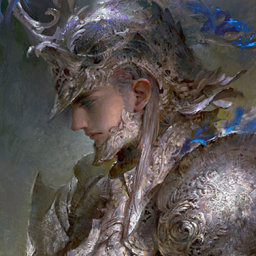 | Agtainas the Great was Eathonie's son. He expanded the empire to its maximum extent, incorporating the eastern lands, the Offecne Flats, to their natural border in the east, the Vercenaean Mountains. He established the southern border at the northern edge of the Sarrena Desert. Agtainas did not venture into the Central Sarrena, Thaniveturs' hinterland, a land rich in oases and small bitter lakes that give access to the Southern Seas. His conquests took and end towards the end of his reign, after a major battle against the Gammassetae, a Tsirvi nomadic tribal confederation, ended in a draw. Hervephè claimed that Agtainas died on 12 Mësle, after a reign of 28 years (5836 a 5864). He was succeeded by his son, Ar'hovihtir. |
 | Ar'hovihtir I, the son of Agtainas the Great, had a short rule, although he took profit from it. The emperor managed to take definitive control of the Cyrrean Straits, on the western edge of the empire, and pacified the neighbouring regions of Cyrrenne and Neube, which became tributary kingdoms ruled by members of his dynasty. He preferred to rule from his office than go to war, and he's known to be a law reformer who touched almost every aspect of religion, economy, and imperial administration. He founded cities in the Trader Seas, facilitating the further colonization of the region, and began planning the construction of the Trade Canals towards the end of his regin. He is less known for being a magician and genetic researcher who wrote several books on genetics and biotechnology, most of them now lost. For that knowledge and research he did, he had an indirect role in the sociopolitical controveries towards the end of his dynasty. He died in 5872, childless, and, according to the official records, was succeeded by his younger brother, Bardiànon. |
 | Bardiànon's rule was shorter than his predecessor, and surrounded in mystery and shadows. Although tradition makes him Ar'hovihtir's younger brother, some historians claim that he was his lover, Aphondas, while some others say he was an illegitimate son, or a nephew. There are sharply divided views on his life. Bardiànon either ruled the Eleuthean Empire for a few months in 5872, or was impersonated by a nigromantic called Asmigtas, until he was toppled by Coraionas the Great. He died at the end of 5872 or in the first weeks of 5873. |
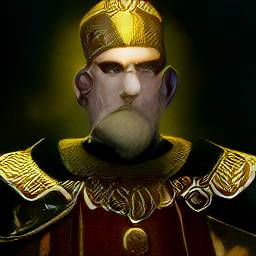 | Coraionas the Great ascended the throne by overthrowing the legitimate Corhoenid monarch Bardiànon, whom he later fabricated to be an imposter named Asmigtas, a real wizard of Bardiànon's time. The new king met with rebellions throughout his empire and quelled them each time; a major event in Coraionas' life was his expedition to subjugate Neube and punish Saethene and Tarerae for their participation in the Igenean Revolt. Although his campaign ultimately resulted in failure at the Battle of Raèthon, he succeeded in the re-subjugation of Cyrrenne and expanded the Dhammaratian Empire through his conquests of Feàmich and the Northern Seas. Coraionas organized the empire by dividing it into administrative provinces that were governed by dukes, while subsidiary states (the so-called "petty kingdoms") were ruled by close members of his dynasty, as Agtainas the Great already did. He organized the Eleuthean monetary system, and made Archaic Eleuthean the official language of the administration, based on some previous reforms by Ar'hovihtir I. He died in the autumn of 5908, after 36 years of reign. |
 | Tassandanie I succeeded his father, Coraionas the Great, after a short throne dispute with his elder brother Phalladas, born from a previous marriage before Coraionas accession to the throne. Following the steps of her father, Tassandanie took a series of standarizing reforms: she unified the weighing and measuring systems, and started the construction of paved roads beyond the Ruvai, connecting all major urban centers throughout the empire. Aware of his father's problems during the conquest of the Northern Seas, Tassandanie built the first imperial fleet, and ordered plans for the construction of an air-and-space fleet, as well as a series of satellites to begin taking control of the outer space around Aerglè. Through these changes, the Eleuthean Empire became centralized and unified. Tassandanie worked on other construction projects throughout the empire, primarily focusing on Ruvai Barnusa, Thaniveturs, Centhedni, Isternat, and the Trader Seas. She had the cliff-face Orènthar Inscription carved at Mount Orènthar to record her feats, which involved no wars nor conquests; its inscription is an important testimony of the Old Dhammaratian language. She reigned from 5908 to 5929, and was succeeded by one of her daughters, Luaducie. |
 | Luaducie was Tassandanie's third daughter, and succeeded her mother shorty after she died. She's known as "the Mournful Queen" or "Luaducie the Mournful", which is explained as the neverending sorrow and sadness she had throughout her reign due to her mother's tragic final days, when she was assassinated by one of her generals, Arthyboadas, although that seems to be a story conflated much later as a tragedy play. Caenie tells us in her Lives of the Corhoenids that Luaducie's sorrow was due to her foretelling powers, which foresaw his firstborn's short life years before he was born. Her reign is remembered for her defense of a separation of religion and state, based on reason and ancient historical accounts, as well as an approximation to a less absolutist ruling, for what she was sometimes known as "the republican empress". She's also known for her smooth administration, always seeking pacts and treaties rather than open confrontation and war. She briefly fought, however, the Gammassetae Kingdom, the empire's main opponent, based on the Tsirvian Highlands; although, through convoluted politics, she managed to derive the Gammassetaean interests towards the south, far from the empire. She reigned for forty-one years, from 5929 to 5970, when she abdicated in favour of her firstborn, Corvè. |
 | Corvè the Lance, son of Luaducie, succeeded her mother after she abdicated at age 86. Like her mother, Corvè had democratic ideas, although he never tried to turn the empire into a constitutional monarchical confederacy, like his detractors said so often. He gave royal charts to some cities, which implied important degrees of autonomy for them and a generalized economic growth throughout the empire, and pacified Mhuse's desires of independence with a special autonomous regime for the city and its land, the Anthologicat. For his ideas and his charming character, he was loved by the people, and he loved hunting, spear contests (from which his moniker), courtly love (quite old-fashioned in his lifetime), and spring's poetry festivals much more than governing the empire. He reigned for seven years (5970 to 5977), until he died in a hunting accident at age 32, and was succeeded by her twin daughters. |
 | Dulmie & Nuble, the twin sisters, were the only children of Corvè and Myrienne. After Corve's death there was some dispute on who should succeed him, but empress Myrienne fought for her daughters, and they were crowned two years after, in 5979, still minors. During their minority, her mother and the Royal Cabinet ruled the empire, and some law reforms were required to grant a co-rule for the sisters. Dulmie and Nuble were popularly known as "Spring and Storm" due to their almost opposed characters, but that was never a problem, rather a complement, sinced they always worked as a perfect duo. They were seen as a continuation of their father's spirit, and, certainly, they loved the courtly love style of ruling. Her reign, however, saw the rise of some social controversies caused by the genetic and biotechnological advances attained during the previous decades, and they were forced to fleed the empire and seek refuge in the Trader Seas, first, and then in the Sarrena, after the eruption of the Second Civil War. Although they never resigned the throne, their effective rule ended in the year 5992, when Dirmas crowned himself emperor of Dhammarat. |
Cöresgat Dynasty
The Cöresgat Dynasty succeeded the Corhoenids during the Eleuthean First Civil War (5990 to 5993), when Dirmas usurped the throne at Ruvai Barnusa. The dynasty was known as "the Deformed Emperors" or "the Grotesque Emperors", because of its monarchs' experiments with biotechnology and genetic enhancement, which deformed their faces and bodies.
| Image | Biography |
|---|---|
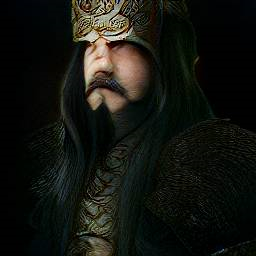 | Dirmas II of Cöresgat, a fervent follower of the biotechnological discoveries made before and during his life, formally established the Rhoa er Xavagdë (Enhancement Way) in the year 5993, when he crowned himself emperor of Eleuthea. By that way, made legal by imperial decree, genetic manipulation was to be applied on all citizens of the Empire in order to improve the health and natural capabilities of Eleutheans. The policy soon found a strong opposition by many, who saw the Xavagdë Way as a form of genocide applied to the other sentient Aerglean species. Most opponents were crushed in various social clashes during Dirmas' rule, with the rest fleeing to empire, to Dulmie and Nuble's court-in-exile, in Tharbanna. His reign was recognized only in Ruvai Barnusa, the Ruvai, Ivressë, and part of the Trader Seas. The length of his reign is disputed, but he didn't last longer than 5996. |
 | Ar'hovihtir II ruled the eastern Trader Seas and some provinces in the southeastern Offecne Flats, and, initially, opposed Dirmas' II rule. Tradition makes him an uncle of Dirmas, although Xèlon says he was an older brother, but he's an unreliable source. After the assassination of Dirmas II, Ar'hovihtir, who had already taken the title of emperor as Ar'hovihtir II in 5993 or 5994, settled in Ruvai Barnusa and effectively ruled the core of the empire, but the social and political environment, still ressented from the civil war, proved fatal, and his reign was short-lived. He died while sleeping in the summer of 5997, leaving the realm, then divided, on the brink of a new war. |
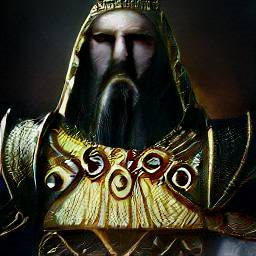 | Dirmas III, a general of the Eleuthean imperial armies during Dulmie and Nuble's reign, soon gained the recognition of Ar'hovihtir's regions, on the empire's southeastern corner, and took Ruvai Barnusa with an army of soldiers and Xavagdë followers. That was seen as an uprising by the capital's and the empire's bureacratic castes, and many members of the imperial administration were killed duting the weeks that followed the taking of the capital. Although Dirmas III sought peace, during his reign, the Eleuthean Second Civil War (6001 to 6006) took place, instigated by his wife, empress Quardelli, and some of his counsellors and generals, who were under the empress' shadow. He reigned for seven years until his assasination, in mysterious circumstances, in the year 6004. |
 | Quardelli managed some areas of the imperial administration during her husband's rule, and she took full control of the empire, at least nominally, after his death, during the Eleuthean Second Civil War. Although she was empress consort of Dirmas III, she had her own political agenda and defended further development of the Xavagdë Way, and unlike her husband, who preferred a more moderate approach in order to mitigate the deformities and health problems caused by it. It is believed that she was one of the main actors who dragged the realm into the Second Civil War, and for that reason she's remembered as a very manipulative individual, the source of the archetype of the machiavellian ruler in later narratives. She's also remembered for making serious advances in the air-and-space imperial fleet, her reign seeing the moment when the first Eleuthean military satellites were put into space. Little more is known about her reign. Some minor rebellions are mentioned by some historians, and in excerpts from Tòrias, some harem intrigues are recorded, in which she played a disreputable part. The exact moment and circumstances of her death are a mystery surrounded by legend and rumours, but we know that she was succeeded by two other rulers, short-lived, and from her, the next dynasty, known as "the Golden Emperors", originates. |
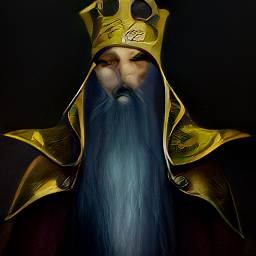 | Coraionas II is the regal name of Arhax, an individual of obscure origin who was crowned emperor of Eleuthea in the spring equinox of year 6008-6009. Certain contemporary sources tell that he had a weird accent, to the point that some later sources claimed that he was a foreigner, but historians like Armadas and Àrnivon affirm that it was due to his facial deformities. Soon after his accession, Coraionas II faced opposition from his younger brother Navatharras the Younger, who assembled an army composed of troops from his province as well as mercenaries from the Tsirvian Highlands. The use of Tsirvis in Navatharras' bid for the throne was seen with dismay from many regions and social classes throughout the empire, and that proved crucial in his defeat at the battle of Autunax in 6011. Following this, Coraionas II had to contend with several other revolts; a revolt by Gövaras I in Feàrmich between 6012–6013, by the eastern provinces in c. 6015, and most importantly, the revolts by the western dukes between 6012 and 6020. Thaniveturs saw itself independent during a short period (6012 to early 6014), until the emperor retook the city; that was his only notorious victory, the others being dull affairs of state led by bureaucrats and generals. Coraionas II died after a long illness in the year 6020, and was succeded by his maternal first cousin, Coraionas III. |
 | Coraionas III, first cousin to Coraionas II, managed to reunite the core lands of the empire, although some eastern regions escaped from his rule. He made important progress on the building of the air-and-space imperial fleet, and his reign also saw some biotechnological improvements that allowed a better application of the Xavagdë Way. There is evidence for a renewed building policy at Harbathhani in his later life, where the emperor erected a new palace and built his own tomb, and began long-term projects such as the Unfinished Bridge, the Palace of the Palms, and the Starry Gate. Coraionas III died by poison, administered by one of his army commanders, Berbè, in 6028. The reasons are unclear, especially given the emperor's military successes, but it is believed that his poor health was a main reason for the regicide. Coraionas III's early death, however, proved to be a problematic issue for Eleuthea, and may have played a role in the weakening of the empire. The majority of Coraionas III's sons, with the exception of Resas and Ebthinas, were also murdered by Berbè. Then, Berbè, acting as kingmaker, put the young Resas (Coraionas IV) on the throne, but he was killed shortly after, together with Berbè and his supporters. |
Golden Dynasty
The Cöresgat Dynasty was followed by more monarchs with deformed faces and bodies. The next dynasty saw short-lived rulers with physical traits so grotesque, that most hid their faces and bodies under full golden helmets and attire. That gave the dynasty its name: the Golden Emperors, or the Golden Dynasty.
| Image | Biography |
|---|---|
 | Camrè I came to the Eleuthean throne shortly after Resas (Coraionas IV) murder. This ruler is not counted among the Eleuthean monarchs because he acceded the throne illegaly. Therefore, after Coraionas III comes Camrè I. Contrary to his predecessor, Camrè I was a distant member of the Corhoenid dynasty. During his early career, he was reportedly an obscure figure among his peers and first rose to prominence during the Yllysian expedition of Coraionas III in the 6020s. As a reward for his bravery, he was given the province of Riamenë. Around 6025, he was placed in charge of the royal postal service, a high-ranking position. After Coraionas III's death and the subsequent death of his assassins and detractors, Camrè I was swiftly installed on the throne by the empire's high-ranking bureacratic circles, who sought definitive peace and the reunification of the Eleuthean Empire. His first ruling years were quite peaceful, according to contemporary sources, but in 6034, Agthanernas the Great, another Corhoenid (he was a descendant of Coraionas the Great's brother's line) began his invasion of the Eleuthean Empire from the Neube region, and subsequently defeated Camrè I in several battles before looting and destroying Harbathhani, the ancient capital, by fire in 6036. With the Eleuthean Empire now effectively under Agthanernas' control, Camrè I fled Ruvai Barnusa and disappeared from history, until some decades later his royal tomb was found near Ryza, by the southern shore of the Censayner Sea. Camrè I is partially remembered in Eleuthean and Ybrearmèllean traditions as Cambra, the last king of the mythological Avagdean dynasty, which reflected memories of his own reign, that of Coraionas III, and, in general, the Corhoenids. |
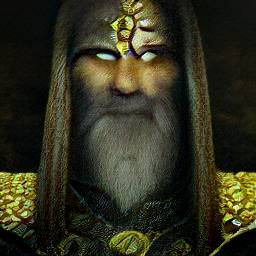 | Vínnon Erhedennas came to power after the death of Agthanernas, which took place half a year after the burning of Harbathhani. Despite Agthanernas' disruption, his invasion accelerated the reunification of the empire, and the Golden Dynasty took profit from the event to fasten its power. For that reason, some historians refer to that dynasty as the Agthanernian Dynasty, although Agthanernas was never an Eleuthean monarch. Born as Erhedennas, Vínnon was the regal name he chose for himself, and his short reign was marked by pacification efforts without abandoning the Xavagdë Way. He desired to abandon the way to space, but powers inside the court aborted his plans, for he served merely as a figurehead and as the pawn of a series of powerful generals and imperial high-rank counsellors. He died in the winter solstice of 6039, in unknown circumstances. |
 | bio3 |
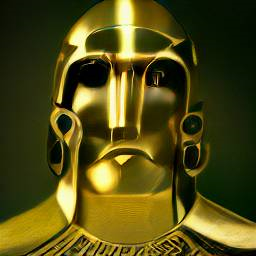 | bio4 |
 | bio5 |
 | bio5 |
| Image | Biography |
|---|---|
| bio1 | |
| bio2 | |
| bio3 | |
| bio4 | |
| bio5 |
| Image | Biography |
|---|---|
| bio1 | |
| bio2 | |
| bio3 | |
| bio4 | |
| bio5 |
